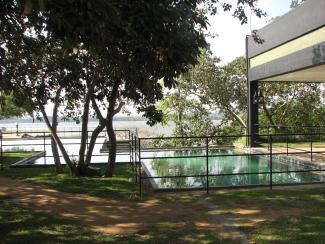
View from a roof terrace of Heritance Kandalama Hotel, Sri Lanka. Architect: Geoffrey Bawa. Photo credit: author.
Divya Kumar-Dumas
PhD Student, Department of South Asia Studies
A visit to Sri Lanka this past August, funded in part by the SouthAsia Center, prompted multi-layered reflection on the island's landscape. My pint-sized travel companion tickled tour guides by calling it 'GreenSriLanka' all in one breath. In contrast to previous experiences of the subcontinent, 'lush', 'green' and 'clean' accurately describe the entire roadside stretch from airport in Western Province to my destination - landscape architecture at Sigiriya in Central Province, an important focus of World Heritage beholding since the 1980s.
I participated at a colloquium titled "Maritime Trade and Cultural Exchanges in the Indian Ocean", held at a luxury hotel just outside Sigiriya, which set the scene for the serious assembly of scholars discussing the variety of early evidence for Indian Ocean networks hinged on Sri Lanka. Glass ingots, cowrie shells, images, texts, and other trade goods were some topics. With thanks to Daud Ali and Osmund Bopearachchi, I presented my current work on the medieval landscape architecture of Sigiriya and its production of marvel among early visitors.
Colloquium participants were also immersed in the framed landscape. Tea and lunch in indoor-outdoor structures built for trees and men, cocktails among critter sounds, a pool with a view. I visited the World Heritage destination in context - via the clean, green backcountry roads of tour guides who made their homes in its landscape.
A cynic might attribute cleanliness to the impact of tourism on the island. And certainly the tourism industry is growing steadily in this post-conflict nation. But according to the World Travel and Tourism Council's Economic Impact Study of 2013, Sri Lanka ranks well behind the world average for tourism's direct and indirect contribution to GDP (quite far behind India, Thailand, and Malaysia in fact). Tourism cannot be the only source for the care with which inhabitants manage their vernacular landscape.
Well outside the capital city, careful door and window ornamentation on otherwise basic residential structures matched their well-tended flowering gardens for style. Luxury hotels seem to build upon this innate sense, a play with materials and products of the larger landscape. Built environment is earth, wood, natural stone, exuberant vegetation, fragrant frangipani, water, sky, and bright sunlight. The relaxed, somewhat smiling, countenances of people also contributed to my sense of encountering an island idyll: Life is good along the main roads of Sri Lanka in 2013.
